Motorsports Racing News & Blog Articles
Church of MO: 2003 Ducati Monster 1000
If one were a slightly more casual Ducati fan, who wanted a classic to blip around in the post-pandemic on more than one to tear up the track with, one could do much worse than this 20-year old 2003 Ducati Monster 1000. Ten years after the original Monster, they’d already begun sticking liquid-cooled L-twins into everybody’s favorite naked bike. But the new 1000 Dual Spark air-cooled engine in the ’03 Monster 1000 was just as torquey, less pricey and complicated – plus the new air-cooled bike was much easier on the body and the occhi. Take it away, Yossef!
By Yossef Schvetz Mar. 16, 2003
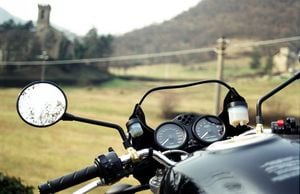
A full decade after the Monster’s birth, this thing still looks the biz regardless of the IQ level of certain owners–a remarkable achievement in a time when companies are busy designing and redesigning their wares in cycles of three or four years or even less, seeking eternal young looks. You can bet your seating member that Ducati are well aware of the worth of their golden-egg laying chicken [must be an Italian thing–Ed.]. More than 100,000 Monsters of varying displacements have been sold since `93–which isn’t peanuts even by Japanese mass production standards–without any major design changes. It wouldn’t be wrong to assume that without Miguel Galluzzi’s master stroke (the Monster’s designer), Ducati might not have survived the ’90s.
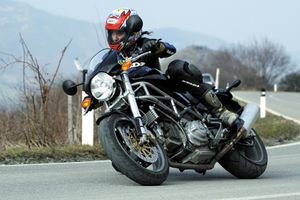
Evergreen as the Monster has always been, time doesn’t stand still. The naked class is growing fast, all the biggies have contenders now, a serious update for the good old Monster was due. At first sight it seems like nothing has changed much and it’ll be hard to blame Ducati for not messing with a winning formula. Every tube of that unique and exposed trellis frame seems to create a perfect dialog with its neighbors, and moving one by even half an inch would be sacrilege. The brain-shaped fuel tank sits on top of the frame in perfect poise and balances with its softness the frame’s rigid lines. The air-cooled power unit has gained classical sculpture status and keeps the last ties with Ducati’s glorious past as it was originally penned by the one and only Fabio Taglioni, AKA Dr.T, the grandfather of all cool Ducatis. A frame, an engine and a fuel tank. Life can’t be simpler than that.
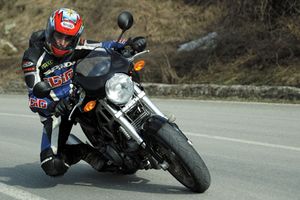
So the big news about the new Monster is in the details. The major “detail” is of course the new Dual Spark 1000cc engine. Unlike a decade ago, there is serious money now in Ducati, serious enough to allow a total revamp of the trusty power unit. The myriad changes to the air-cooled mill have been exhaustively covered in the SuperSport 1000DS launch report.The big growth in displacement, the deeply massaged head with enlarged valves, and above all the extra spark plug per pot are enough to justify an “all-new” heading. Like all Monsters for model year `03, the DS1000 also gets a strengthened frame, and a new swingarm and suspension linkage lifted from the 916-powered Monster S4. Ducati claims a 30-percent increase in overall stiffness for this frame and a comfier riding position–claims which felt justified when I tested the S4 a year and a half ago.
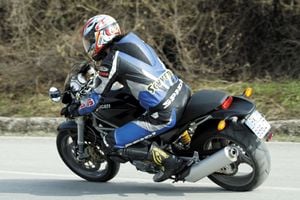
There are also plenty of smaller updates too, like a new and classy instrument cluster, a small fairing, a rear suspension with ride height adjustability, plenty of small carbon fiber covers and protectors, a fully adjustable Showa USD fork… Minimalist the Monster might well be but the bike I picked up from Ducati’s parking lot looked way better finished and detailed than the old 900 ever was. Come to think of it, this Duc looks better finished than even the exotic S4 I sampled, a Monster that didn’t quite know what to do with its exposed radiator and rubber hoses. Unlike the S4, which seemed like a quick effort to close the gap in front of powerful new naked models, the new DS1000 Monster is much more coherent while remaining faithful to the original spirit of the family. None of the flimsy brackets holding the S4’s bikini fairing for instance. The only visual detriment I can point my finger at is the high-voltage cable for the extra spark plug of the front cylinder, which juts out from the timing belt cover like a sore thumb.
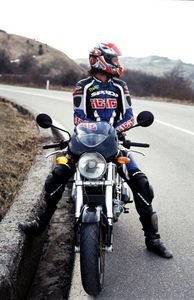
This little complaint is soon forgotten as I sample the huge change in oomph brought about by the new engine and its extra sparks. Throttle response is totally awesome! A light throttle blip and the front wheel paws the air effortlessly. Do the same in second, and those wheelies just get longer. Pro monowheelers more courageous than me should have a field day with this one. Ducati knows a thing or two about fuel injecting big lungs, and the DS1000 surges forward without any hesitation. With a light crankshaft and not much of a flywheel, the new mill pushes in strong and linear fashion from 3000 right into the rev limiter at 8,700 rpm: 84 horsepower might not sound like much, but with a torque curve that bulges up early and a relatively light weight of 416 pounds (wet), the M1000 supplies plenty of fun in roll-ons, feeling just as quick as the taller-geared S4 at medium speeds. Being also a full 40 pounds lighter than the similarly powered Multistrada and physically smaller, the Monster feels much livelier and responsive all around.The cycle side of the equation leaves good early impressions too. A frame as stiff as a small steel bridge, sticky Pirellis, wide handlebars and a Ducati road tester on a Multistrada exiting the factory gate at the same time as me means I immediately go into attack mode. Seemingly inspired by my morning-ride idiot, the Ducati tester dives into a fast roundabout just outside the factory, all guns blazing, without giving much thought to the cold tires. Whatever. These guys know a thing or two `bout frames too. The M1000 is so confidence-inspiring from the word go, responds so sincerely to my inputs, that all thoughts of slowly learning its responses feel superfluous. Just ride the wheels off the thing. Soon enough we join the thick Bologna traffic–a good occasion to check the Monster’s table manners.
Bologna might be in Italy but Ducati’s ease of operation is getting more oriental by the year. Gearshifting is buttery and none of the jerkiness of the old 900 or Monster S4 is present. The only item to still remind you that you are on a Ducati is stiffish clutch pull that gives your left forearm a good workout in stop-n-go traffic. This thing is so small and nimble it never feels liter-size big, easy to understand then why you get to see so many Monsters in the streets of Italian cities. As good a city dweller as the M1000 is, the fun part was yet to come. It’s on slow-to-medium speed twisties, like the ones found in the hills of Romagnola, just south of Bologna, where the Monster really delivers its best. At first you are suddenly aware that as with most Ducatis, turn-in is not lightning quick. The Monster requires decisive inputs, yet the combination of a rock-solid front end and the ultrasecure feeling that the whole plot conveys at high lean angles allows me to attack with deadly effectiveness the very roads used by Ducati testers. The Monster remains a true Ducati in the sense that it asks you to plan a bit your line beforehand, rewarding you with superb midturn control. On my first test day the high roads were still pretty cold, damp and dirty from the last snow fall, not the ideal conditions for a supersports tool and indeed, I had a good time closing up on sportbike riders. The fluid power delivery urges you to roll on early, gaining yards on hesitating in-line fours with riders leaning heavily on lowish clip-ons. As the roads dry some more, I am able to check out ground clearance. On less than ideal tarmac, the front corners of the silencer touched once or twice at knee dragging angles, a known Monster issue–and one you can address now with the ride-height adjustable rear linkage if you so choose.
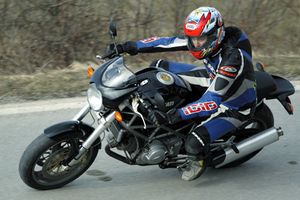
If you are a real squid or want to do track days, just fit underseat pipes. Other than that, the Monster 1000 is a superb canyon riding platform. Impudent small wheelies as you exit second gear curves wiggle your bars as the front regains contact, the extreme stability as you deep brake into turns, all in all, good fun without punishing your wrists. Talking about braking, the obligatory Brembos are pretty strong but do not excel in initial bite or feel, especially when cold. Last obligatory Ducati issue that regards mountain roads riding is of course the engine. Just like with the Multistrada, the 1000DS mill lets you stay in one gear and concentrate on your lines rather than on keeping the engine on the boil.
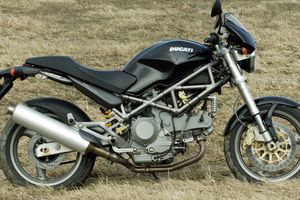
After the photo session, I am left mid-Toscana with plenty of time on my hands to sport-tour or just plain scratch. The hours pass and, still, everything’s feeling OK. A comfortable Monster at last? I can still recall the acute burning sensation in my tailbone when I once rode an M900 for a long stretch. Even the supposedly comfier S4’s seat mashed my buttocks in no time at all, so I don’t really know who to blame but this Monster is long-range comfy and I’m almost sure my anatomy hasn’t been altered. There seems to be slightly more seat to footpeg distance and a different cut to the seat foam. The handlebars ends tip down for a more ergonomic hold, and the Showa suspension does a real good job swallowing all sorts of road imperfections (although for really spirited riding I added a few clicks of damping).
So forget about punishing Ducatis, someone in the factory seems to be paying real attention to the small details that count. This road test eventually turned into a full-blown Tuscany tour that showed me this new Monster has indeed a much wider use spectrum. Later on, my girlfriend even found the small passenger seat acceptable, and we even tackled a pretty steep hard-packed trail. Try that with your sportbike.
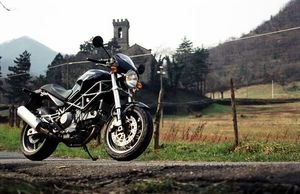
Before I convince half the world to move on to naked bikes, the genre has its limitations too. Back on the autostrada, it turns out that vestigial fairing isn’t much use in low-altitude flight. The engine has no problem pushing the M1000 to 120 or 130 even, but your neck muscles do have some trouble keeping your head from detaching from the rest of your body. Even at 100 mph, my girlfriend was making wild gesticulations trying to slow me down, having trouble staying put with no hand grabs around. Back to 85- 90 cruising it was. At that speed, the Monster is kind of acceptable for longer highway cruising and the engine emmits just a vibrationless and gentle rumble. So where were we? A nice city tool, a mean canyon carver, we had some off-road fun even. Just forget about long to mid range highway droning, as it gets old kind of quick. My large soft saddle bags wouldn’t even fit on this one.
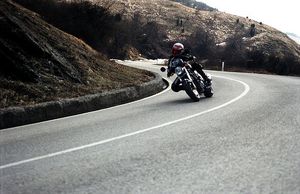
When I tested the the 916-powered S4, I was somewhat resentful about the premium price. There is hope now for souls captivated by the essentialist Monster formula; the M1000DS supplies most of the fun of its watercooled brother at a list price that’s 20-percent lower. The only thing you’ll miss would be the extra top end, but in the context of naked and pared-down-to-their-bones bikes such as the Monster, it just really doesn’t matter. Visually speaking, the liquid-cooled Monster can’t hold a candle to the classic look of Taglioni’s last creation. With its newfound fuel-injected vigor, there is no better frame in which to display this air-cooled masterpiece than the Monster.
Specifications
ENGINE
992cc air-cooled L-twin, 2v/cyl., desmodromic
Bore x Stroke: 94 x 71,5mm
Compression ratio: 10:1
Power: 62 kW – 84 HP @ 8000 rpm
Torque: 84 Nm – 8,5 kgm @ 6000 rpm
Fuel injection: Marelli, two 45mm throttle bodies
Exhaust: two aluminum mufflers with 3-way catalytic converter (not on USA version) in compliance with Euro1 standard regulations
Gearbox: 6-speed; dry-multiplate clutch
Ratios: 1st 37/15, 2nd 30/17, 3th 27/20, 4th 24/22, 5th 23/24, 6th 24/28
Primary drive: Straight-cut gears; 1.84
Final drive: Chain, 15/39
CHASSIS
Frame: Round-tube steel trellis
Wheelbase: 1440 mm/ 56,7 in
Rake/trail: 240/ yes
Front suspension: 43mm inverted Showa; fully adjustable (not adjustable on Dark version), 130mm travel
Rear suspension: progressive linkage with Sachs adjustable monoshock. aluminum swing-arm (steel swing-arm on Dark version), 148mm travel
Front brake: two 320mm discs, four-piston calipers
Rear brake: 245mm disc, two-piston caliper
Wheels: three-spoke light alloy; 3.50 x 17/ 5.5 x 17 in.
Tyres: 120/70-ZR17, 180/55-ZR17
Fuel capacity: 15 L / 3,9 US gal (including 3,5 L / 0,9 US gal reserve)
Claimed weight*: 189 kg / 416 lb
Seat height: 800 mm / 31.5 in
Instruments: Electronic speedometer, rev counter, neutral light, oil pressure warning light, low fuel warning light, high beam indicator, turn signals, immobilizer, LCD oil temperature, LCD clock
Warranty: two years unlimited mileage
Tank colors: Red, yellow, blue, black, metallic grey (Dark version: matt black, silver grey)
$$$$: 11,095
* includes battery and lubricants, no fuel…
.jpg)
The post Church of MO: 2003 Ducati Monster 1000 appeared first on Motorcycle.com.
Copyright
© Motorcycle.com

